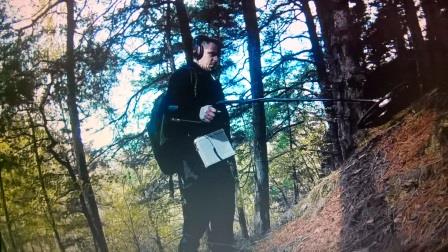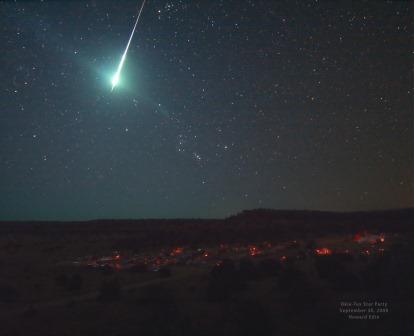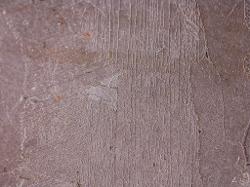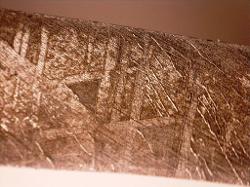ABOUT AUTOR I am a traveler, hunter and collector, iron and stone-iron meteorites. My fields of research are planetary geology, impact structures, Earth and solar system development.  I am a member of the International Society for Meteoritics and Planetary Science, the IMCA encyclopedia of Meteorites and MetBase. My name is Michal Tomeček and I come from the Czech Republic. My main activity is searching for forgotten or very old iron meteorites and research impact structures.
I am a member of the International Society for Meteoritics and Planetary Science, the IMCA encyclopedia of Meteorites and MetBase. My name is Michal Tomeček and I come from the Czech Republic. My main activity is searching for forgotten or very old iron meteorites and research impact structures.
BASIC TERMINOLOGY
What is a meteorite? The meteorite is generally understood as a natural extraterrestrial body that hit the Earth's surface, it survived the passage through the atmosphere. This body may be either an asteroid, meteoroid or comet. The difference between asteroids and meteoroids is in their size and by the asteroid in the atmosphere does not lose its original speed or mass, struck the earth creates an impact crater, while a meteoroid that is in the earth's atmosphere is changing, meteor * may be in the atmosphere to evaporate all or most its initial mass and its original speed is sufficiently slowed by friction with air molecules, so that in the final phase of flight atmosphere free fall. Upon landing on Earth we call it a meteorite.
* Meteor: It is a term denoting lighting effect linked to the entry and movement of meteoroid in the atmosphere. If a meteor brighter than the glow of the brightest planets is called a fireball.
NAMES OF METEORITES.
THEY ARE DERIVED FROM THE PLACE OR REGION OF THEIR FIRST AWARD.
NWA: meteorites: They are generally taken into account all meteorites found in North-West-Africa.
NEA: meteorites: They are generally taken into account all meteorites found in North-East-Africa.
ALHA, ALH: meteorites: They are generally taken into account all meteorites found in Alan Hills, Antarctica.
A: and Y: meteorites: They are generally taken into account all meteorites found in Antarctica (Collected by National Institute of Polar Research, Japan).
B: meteorites: They are generally taken into account all meteorites found in Atarctica Collected by US Antarctic Search for Meteorites program (ANSMET).
ALL PREFIXES ARE ANTARCTICA:
BOW, BUC, CMS, DNG, DAV, DRPA, DRP, DOM, EETA, EET, FIN, FRO, GDR, GEO, DRA, GRV, ILD, JOH, KLE, LAP, LAR, LEW, LON, MAC, MCY, META, MET, MIB, MIL, MBRA, CRA, DRW, FLE, HOW, JAK, PRA, PRE, WAL, WSG, ODE, OTTA, PAT, PCA, PGPA, QUE, RKPA, RKP, ROB, RBT, SAN, SCO, STG, STE, SZA, TYR, TEN, TIL, WIS.

Fireball image: NASA
- MG - ir
IRON METEORITES
IAB, IIAB, IIIAB, IVAB, UNGROUPED, OTHER. IAB COMPLEX THE MAIN GROUP.
MG - iron meteorite: A meteorite that is dominantly composed of Fe-Ni metal and that crystallized from a melt.
Complex - An iron meteorite belonging to the IAB complex that has not been classified into a subgroup.
IAB complex: An association of iron meteorites, including the former groups IAB and IIICD.
SLM - An iron meteorite belonging to the low-Au, medium-Ni subgroup (sLM) of the IAB complex. Ung - iron meteorite belonging to the IAB complex that has not been classified into a subgroups.
SHH - An iron meteorite belonging to the high-Au, high-Ni subgroup (sHH) of the IAB complex.
SLH - An iron meteorite belonging to the low-Au, high-Ni subgroup (sLH) of the IAB complex.
SLL - An iron meteorite belonging to the low-Au, low-Ni subgroup (sLL) of the IAB complex.
SHL - An iron meteorite belonging to the high-Au, low-Ni subgroup (sHL) of the IAB complex.
an - An iron meteorite belonging to the IAB complex that has anomalous properties.
Classification of chemical groups.
IIAB irons - An iron meteorite belonging to chemical group IIAB.
IIIAB irons - An iron meteorite belonging to chemical group IIIAB.
IC irons - An iron meteorite belonging to chemical group IC.
IIC irons - An iron meteorite belonging to chemical group IIC.
IID irons - An iron meteorite belonging to chemical group IID.
IIE irons - An iron meteorite belonging to chemical group IIE.
IIF irons - An iron meteorite belonging to chemical group IIF.
IIG irons - An iron meteorite belonging to chemical group IIG.
IIIE irons - An iron meteorite belonging to chemical group IIIE.
IIIF irons - An iron meteorite belonging to chemical group IIIF.
IVA irons - An iron meteorite belonging to chemical group IVA.
IVB irons - An iron meteorite belonging to chemical group IVB.
an.with anomalous properties
Depending on nickel content and crystallization.
HEXAHEDRITES ( HEX )
Nickel - 4,5% – 6,5% Texture - Neuman Lines
OCTAHEDRITES ( O )
Nickel - 6,5% - 17,5% Texture - Widmanstätten Lines
COARSEST OCTAHEDRITE ( Ogg )
Nickel – 6,5% - 8,5%
MEDIUM OCTAHEDRITE ( Om )
Nickel – 7,4% - 10,3%
FINE, FINEST OCTAHEDRITE (Of, Off )
Nickel – 7,8% - 17%
PLESSITIC (Opl )
Kamacite spindles
ATAXITE (D )
Nickel >16% ( High Nickel content )
Neumann lines in Kamacite

Widmanstätten pattern

STONY – IRON METEORITES
PALLASITES
A meteorite that is a mixture of metal and silicates (usually olivine grains).
- PMG Pallasite main group.
- PES A pallasite belonging to the Eagle Station chemical group. The Eagle Station grouplet is named after the Eagle Station meteorite, the type specimen of the grouplet. It is in turned named after Eagle Station, Carroll County Kentucky where it was found.
MESOSIDERITES
A brecciated meteorite containing subequal silicate and metallic components; the silicates are dominantly igneous rock fragments.
Petrologic Types:
- A1-4
- B1-4
- C1-4
CHONDRITES
CARBONACEOUS CHONDRITE (C)
A major class of chondrites that mostly have Mg/Si ratios near the solar value and oxygen isotope compositions that plot below the terrestrial fractionation line.
- CI type Ivuna. The Ivuna (CI) chemical group of carbonaceous chondrites, distinguished by the complete absence of chondrules and refractory inclusions, and high degree of hydration
- CM type Mighei. The Mighei (CM) chemical group of carbonaceous chondrites, distinguished by small chondrules and refractory inclusions (0.3 mm), abundant fine-grained matrix (~70 vol%), and abundant hydrated minerals.
- CO type Ornans. The Ornans (CO) chemical group of carbonaceous chondrites, distinguished by small chondrules and refractory inclusions (<0.2 mm) occupying about half the volume of the rock, and generally showing a low degree of aqueous alteration.
- CV type Vigarano - CVₒₓᴀ type Allende - CVₒₓᴃ type Bali - CVᴿᴱᴰ reduced. Vigarano (CV) chemical group of carbonaceous chondrites, distinguished by large (mm-sized) chondrules, many of which are surrounded by igneous rims, large refractory inclusions and abundant matrix (40 vol%); CV chondrites may be divided into oxidized and reduced subgroups.
- CK type Karoonda. The Karoonda (CK) chemical group of carbonaceous chondrites, distinguished by abundant fine-grained matrix (~75 vol%), mm-sized chondrules that lack igneous rims, relatively few refractory inclusions, and a high degree of oxidation; most CK chondrites have been metamorphosed to type 4 or higher.
- CR type Renazzo. The Renazzo (CR) chemical gorup of carbonaceous chondrites, distinguished by large, abundant porphyritic chondrules (0.7 mm, 50 vol%), many of which have igneous rims, few refractory inclusions, abundant metal (5-8 vol%), and fine-grained matrix that is commonly hydrated (up to 50 vol%).
- CH type ALHA 85085. The high-metal (CH) chemical group of carbonaceous chondrites, similar to Allan Hills 85085; CH chondrites have tiny chondrules and refractory inclusions (~0.02 mm), abundant metal (~20 vol%), no fine-grained matrix except as xenolithic clasts, and rare sulfides consistent with overall low volatile element contents. It is uncertain whether members of the group are true chondrites, as they may have formed slightly later in solar system history.
- CB type Bencubbin - CBᴬ - CBᴮ. Bencubbin-like (CB) association of carbonaceous chondrites. The CBa subgroup is distinguished by cm-sized chondrule-like objects, abundant metal (>half the volume), no fine-grained matrix, and almost no refractory inclusions. The CBb subgroup contains small chondrules (0.2 - 1 mm), abundant metal (~70 vol%), and some refractory inclusions. It is uncertain whether any or all CB meteorites are true chondrites, as they may have formed slightly later in solar system history.
Petrilogic Types:
-
TYPE 1: Designates chondrites which have experienced a high degree of aqueous alteration. Most primary minerals have been replaced by secondary phases and chondrules are generally absent.
- TYPE 2: Designates chondrites which are characterized by abundant hydrated minerals and abundant fine-grained matrix; chondrules are present; sulfides are Ni-bearing
- TYPE 3: Designates chondrites that are characterized by abundant chondrules, low degrees of aqueous alteration, and unequilibrated mineral assemblages. Many of the low-Ca pyroxene grains are monoclinic and exhibit polysynthetic twinning. The type 3 chondrites may be divided into subtypes ranging from 3.00 (least metamorphosed) to 3.9 (nearly metamorphosed to type 4 levels). If primary igneous glass occurs in the chondrules, it belongs to type 3.
- TYPE 4: Designates chondrites that are characterized by abundant chondrules, and have been metamorphosed under conditions sufficient to homogenize olivine compositions and recrystallize fine-grained matrix. Some of the low-Ca pyroxene grains may be monoclinic and exhibit polysynthetic twinning. Primary igneous chondrule glass is absent.
ORDINARY CHONDRITE (OC)
A major class of chondrites, distinguished by sub-solar Mg/Si and refractory/Si ratios, oxygen isotope compositions that plot above the terrestrial fractionation line, and a large volume percentage of chondrules, with only 10-15 vol% fine-grained matrix.
Petrologic Types distinguishing characteristics
- H H3-7 The high-iron (H) chemical group of ordinary chondrites, distinguished by their high siderophile element content, relatively small chondrules (~0.3 mm), and oxygen isotope compositions that are closer to the terrestrial fractionation line than those of other ordinary chondrites.
- L L3-7 The low-iron (L) chemical group of ordinary chondrites, distinguished by their relatively low siderophile element content, moderate sized chondrules (~0.7 mm), and oxygen isotope compositions that intermediate between H and LL group ordinary chondrites.
- LL LL3-7 The low-iron, low metal (LL) chemical group of ordinary chondrites, distinguished by their low siderophile element content, fairly large chondrules (~0.9 mm), and oxygen isotope compositions that are further above the terrestrial fractionation line than those of other ordinary chondrites.
ENSTATITE
A major class of chondrites that mostly have sub-solar Mg/Si and refractory/Si ratios, oxygen isotope compositions that plot near the terrestrial fractionation line, and highly reduced mineral assemblages (containing little FeO, Si-bearing metal, and sulfides of elements normally considered lithophile).
- EH EH3-7 The high-iron (EH) chemical group of enstatite chondrites, distinguished by small chondrules (0.2 mm), abundant metal (~10 vol%) that is rich in Si (~3 wt%), and an extremely reduced mineral assemblage including niningerite (MgS) and perryite (Fe-Ni silicide).
- EL EL3-7 The low-iron (EL) chemical group of enstatite chondrites, distinguished by moderately large chondrules (0.6 mm), abundant metal (~10 vol%) that is Si-bearing (~1 wt%), and an extremely reduced mineral assemblage containing ferroan alabandite ((Fe,Mn)S).
R- chondrites
- Rumuruti R3-6 The Rumuruti (R) group of chondrites does not clearly belong to any of the major classes of chondrites (ordinary, carbonaceous, enstatite); R chondrites have sub-solar Mg/Si and refractory/Si ratios, oxygen isotope compositions that plot above the terrestrial fractionation line and ordinary chondrites, and highly oxidized mineralogy. Come from an asteroid's regolith.
K - chondrites
- Kakangari K A grouplet of chondrites with similarities to Kakangari which do not fit into the major classes of chondrites such as carbonaceous, ordinary, or enstatite.
Ungrouped
An ungrouped chondrite that has not or can not be assigned to one of the major classes like carbonaceous chondrites or ordinary chondrites.
ACHONDRITES
PRIMITIVE
A meteorite that has lost its chondritic texture due to heating and partial melting, but still has nearly chondritic composition.
-
Acaulcoites: Acapulcoites, named after the Acapulco, Mexico, fall of 1913, and lodranites, named after the Lodran, Pakistan, fall of 1868, are closely related, equigranular meteorites; acapulcoites are finer grained than lodranites and contain rare, relict chondrules, and there are transitional meteorites between the two types (e.g., EET 84302, GRA 95209). Mineral assemblages are similar to, but distinct from those of ordinary chondrites. Compositions are subchondritic, with lodranites showing a higher degree of fractionation.
-
Winonaites: Winonaites, named after the Winona, Arizona, find of 1928, are equigranular rocks, some of which may contain relict chondrules, that have mineralogy and composition that are similar to chondrites.The mineral assemblage is more reduced than that of H chondrites. Winonaites are related to the silicate inclusions found in IAB complex irons.
-
Lodranites: The Lodran meteorite is described as having roughly equal amounts of metal, olivine and pyroxene which make up most of the volume. Other minerals include sulphide, chromite, phosphide and chrome-diopside.
-
Brachinites: Brachinites, named after Brachina, a meteorite found in Australia in 1974, are olivine-rich achondrites that are relatively close to chondrites in many compositional properties, and so are frequently considered to be primitive achondrites. Their true origin is still an open question and not all brachinites may share the same origin
-
Ungrouped: Describes meteorites which have been well-enough characterized to determine that they do not fit into any of the established groups.
MARTIAN
Martian meteorites are martian rocks that were ejected from Mars by impacts and later fell to the Earth as meteorites. Three well-known types are shergottites (basaltic to lherzolitic igneous rocks, named after the Shergotty, India, fall of 1865), nakhlites (clinopyroxenites or wehrlites, formed as cumulate rocks, and named after the Nakhla, Egypt, fall of 1911), and chassignites (dunitic cumulate rocks named after the Chassigny, France, fall of 1815).
- Shergottitesa: Mrtian meteorite belonging to the shergottite type.
- Nakhlites: Martian meteorite belonging to the nakhlite type.
- Chassignitesa: Martian meteorite belonging to the chassignite typ.
- Martian BB: A martian meteorite that is a breccia dominantly composed of basaltic clasts; this martian meteorite is not assigned to the shergottite, nakhlite, or chassignite types.
- ALHA84001 OPX: An orthopyroxene-rich martian meteorite; this martian meteorite is not assigned to the shergottite, nakhlite, or chassignite types.
-
Aubrites: Aubrites, named after the Aubres, France, fall of 1836, are enstatite achondrites. Most are breccias (Shallowater being a notable exception) containing igneous and impact-melted clasts. Like enstatite chondrites, aubrites have highly reduced mineralogy, but they probably do not come from the same parent asteroid as either EH or EL chondrites.
-
Urelites: Ureilites, named after the Novo-Urei, Russia, fall of 1886, are ultramafic achondrites that contain interstitial carbon as graphite or diamond. The majority consist of olivine + uninverted pigeonite. In a few, the pyroxene is augite and/or orthopyroxene instead. In addition, about 10% of ureilites are polymict breccias, containing a few percent of feldspathic material in addition to typical ureilitic components.
HED
- Eucrites -Eucrites are the most abundant type of basaltic achondrite, linked by geochemical traits such as oxygen isotopic ratios and certain elemental ratios, of which Fe/Mn is the most widely cited. The main minerals in eucrites are Fe-rich pyroxene and Na-poor plagioclase. The eucrites are strongly linked with the diogenites and howardites; the three groups are collectively known as HED meteorites and may come from asteroid 4 Vesta.
- Diogenites: Diogenites are an abundant type of achondrite, linked by geochemical traits such as oxygen isotopic ratios and certain elemental ratios, of which Fe/Mn is the most widely cited. The dominant mineral in diogenites is orthopyroxene. The diogenites are strongly linked with two other achondrite groups: eucrites and howardites; the three groups are collectively known as HED meteorites and may come from asteroid 4 Vesta.
- Howardites: Howardites are an abundant group of polymict-breccia achondrites that appear to represent mixtures of eucrites + diogenites (these three linked groups are collectively known as HED meteorites and may come from asteroid 4 Vesta). The main minerals in howardites are pyroxene (largely orthopyroxene) and Na-poor plagioclase. A minority of howardites are rich in solar-wind noble gases and thus inferred to be regolith breccias
- Dunite: Dunite is an igneous, plutonic rock, of ultramafic composition, with coarse-grained or phaneritic texture. The mineral assemblage is greater than 90% olivine, with minor amounts of other minerals such as pyroxene, chromite, magnetite, and pyrope. Dunite is the olivine-rich end-member of the peridotite group of mantle-derived rocks. Dunite and other peridotite rocks are considered the major constituents of the Earth's mantle above a depth of about 400 kilometers. Dunite is rarely found within continental rocks, but where it is found, it typically occurs at the base of ophiolite sequences where slabs of mantle rock from a subduction zone have been thrust onto continental crust by obduction during continental or island arc collisions (orogeny). It is also found in alpine peridotite massifs that represent slivers of sub-continental mantle exposed during collisional orogeny. Dunite typically undergoes retrograde metamorphism in near-surface environments and is altered to serpentinite and soapstone.
-
Angrites: Angrites, named after the Angra dos Reis, Brazil, fall of 1869, are a relatively rare type of basaltic achondrite with low alkali contents, high Ca/Al ratios, and a distinctive mineral assemblage, generally including Al-Ca-Ti-rich pyroxene, Ca-rich plagioclase, and Ca-rich olivine that may have exsolved the mineral kirschsteinite.
LUNAR
Lunar meteorites are lunar rocks that were ejected from the Moon by impacts and later fell to the Earth as meteorites
- Feldspathic breccias: Feldspathic breccias Lunar meteorite that is a breccia of primarily feldspathic lithologies
- .Basaltic: Basaltic Lunar meteorite that is primarily basaltic.
- Polymict: Polymict Lunar meteorite that is primarily anorthositic.
- Gabbro: Gabbro Lunar meteorite that is primarily gabbroic.
METACHONDRITES
- CV
- CR
- En
- H
Relict meteorites
relict meteorite: A highly altered object that may have a meteoritic origin. These are dominantly (>95%) composed of secondary minerals formed on the body on which the object was found.
Copyright © 2014 - 2021, MeteoritesWorld.com
by Michal Tomeček. All Rights Reserved. Images, code, and content on this website are property of MeteoritesWorld.com by Michal Tomeček and are protected by copyright law.